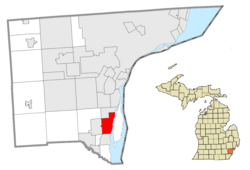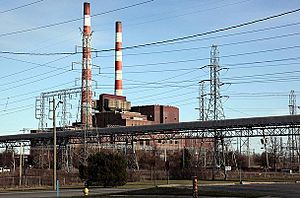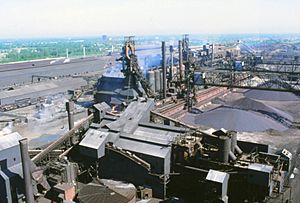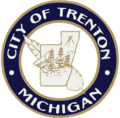Trenton, Michigan facts for kids
Quick facts for kids
Trenton, Michigan
|
||
|---|---|---|
| City of Trenton | ||

Trenton City Hall on Third Street
|
||
|
||

Location within Wayne County
|
||
| Country | ||
| State | ||
| County | ||
| Settled | 1816 | |
| Incorporated | 1855 (village) 1957 (city) |
|
| Government | ||
| • Type | Council–manager | |
| Area | ||
| • City | 7.55 sq mi (19.55 km2) | |
| • Land | 7.24 sq mi (18.76 km2) | |
| • Water | 0.30 sq mi (0.79 km2) | |
| Elevation | 597 ft (182 m) | |
| Population
(2020)
|
||
| • City | 18,544 | |
| • Density | 2,559.91/sq mi (988.38/km2) | |
| • Metro | 4,285,832 (Metro Detroit) | |
| Time zone | UTC-5 (EST) | |
| • Summer (DST) | UTC-4 (EDT) | |
| ZIP code(s) |
48183
|
|
| Area code(s) | 734 | |
| FIPS code | 26-80420 | |
| GNIS feature ID | 1615062 | |
Trenton is a city in Wayne County, Michigan, United States. In 2020, about 18,544 people lived there.
Long ago, a Shawnee village was built in this area by a war chief named Blue Jacket. This was after the 1795 Treaty of Greenville. Later, the Battle of Monguagon happened here during the War of 1812. This battle was between Americans and a group of British and Native American fighters. Today, a special marker in Elizabeth Park remembers this battle. Elizabeth Park was Michigan's first county park, started in 1919. Parts of the Detroit River International Wildlife Refuge are also in southern Trenton.
Trenton used to be part of Monguagon Township. It became a village in 1855 and then a city in 1957. Trenton is one of the "Downriver" towns south of Detroit. These towns are on the west side of the Detroit River. Trenton is known for its beautiful waterfront and growing boating community. Big businesses here include Stellantis-Chrysler's Trenton Engine Plant, Solutia, and the DTE Energy Trenton Channel Power Plant. Beaumont Hospital – Trenton is also in the city and has 203 beds. The old McLouth Steel factory is also located here. The city has the 21,000-square-foot (2,000 m2) Trenton Veterans Memorial Library and a history museum.
Contents
History of Trenton
Abram Caleb Truax is seen as the founder of Trenton. He was part of the local army during the War of 1812. After the war, in 1816, Truax bought a large piece of land along the Detroit River. He built a sawmill, a church, and a store in what is now downtown Trenton.
When Lewis Cass, the governor, set up Monguagon Township in 1827, Truax became its first leader. He planned the village of Truaxton in 1834. A post office called "Monguago" opened there in 1828, with Truax as the first postmaster. The post office name changed to "Truago" in 1837. Then, in 1847, it became "Trenton." This name came from a type of limestone found in a local quarry. Abram Truax's son and daughter, George Brigham Truax and Sophia Slocum, officially mapped the village as Trenton in 1850. The Slocum family later gave their land to the county. This land became Elizabeth Park, named after Elizabeth Slocum.
In 1834, a businessman named Giles Bryan Slocum built a dock. This made Trenton an important stop for steamboats. In 1846, Captain Arthur Edwards started the Detroit & Cleveland Steamboat Company in Trenton. By the late 1880s, Trenton was known for its many shipyards. The nearby village of Sibley, Michigan became part of Trenton in 1929.
Trenton officially became a village in 1855.
A Detroit businessman, Solomon Sibley, started a quarry near Trenton. This quarry was close to what is now Fort Street and Sibley Road. The stone from this quarry was used to build things in Detroit, like Fort Detroit. Later, Austin Church bought the quarry. He used the limestone to make baking soda, which he sold as Arm & Hammer. In 1900, the quarry was the site of the Sibley Quarry explosion.
In the late 1800s and early 1900s, Trenton grew because it was about a day's journey between Detroit and Monroe, Michigan. This meant travelers often stopped overnight in Trenton. In 1911, Edward N. Hines first used painted center lines on River Road (now West Jefferson Avenue). This was a big step for modern road transport.
Trenton added the village of Sibley in 1929. This moved the city's northern border to Sibley Road. Trenton officially became a city in 1957. A small light train ran along West Jefferson to Wyandotte from 1920 to 1934. The tracks were removed in 1942 to help with the war effort.
Trenton's Location and Size
Trenton is located in the southeastern part of Michigan. It sits between Detroit and Monroe, Michigan. The city is on the western bank of the Detroit River. To the east is Grosse Ile, and to the south is Gibraltar. Riverview is to the north. To the west and south are Brownstown Township and Woodhaven.
The city covers about 7.51 square miles (19.45 km2) in total. Most of this, about 7.28 square miles (18.86 km2), is land. The rest, about 0.23 square miles (0.60 km2), is water.
Population of Trenton
| Historical population | |||
|---|---|---|---|
| Census | Pop. | %± | |
| 1880 | 1,103 | — | |
| 1890 | 789 | −28.5% | |
| 1920 | 1,682 | — | |
| 1930 | 4,022 | 139.1% | |
| 1940 | 5,284 | 31.4% | |
| 1950 | 6,222 | 17.8% | |
| 1960 | 18,439 | 196.4% | |
| 1970 | 24,127 | 30.8% | |
| 1980 | 22,762 | −5.7% | |
| 1990 | 20,586 | −9.6% | |
| 2000 | 19,584 | −4.9% | |
| 2010 | 18,853 | −3.7% | |
| 2020 | 18,544 | −1.6% | |
| U.S. Decennial Census | |||
In 2010, there were 18,853 people living in Trenton. There were 7,988 households, and 5,159 families. The city had about 2,590 people per square mile. Most residents, 95.5%, were White. About 1.3% were African American, and 0.5% were Native American. About 0.7% were Asian. People of Hispanic or Latino background made up 3.2% of the population.
The average age in Trenton was 45 years. About 21.3% of residents were under 18. And 19.8% were 65 years or older.
Getting Around Trenton
 M-85: This road is known as Fort Street. It goes north and south through Trenton's center. It connects to Interstate 75 about 3 miles (4.8 km) south of Trenton.
M-85: This road is known as Fort Street. It goes north and south through Trenton's center. It connects to Interstate 75 about 3 miles (4.8 km) south of Trenton.- West Jefferson Avenue: This road also runs north and south. It is along the eastern part of Trenton, near the Detroit River.
- Wayne County Bridge: This bridge connects Trenton to Grosse Ile Township. It crosses the Trenton Channel of the Detroit River.
Trenton's Economy
Trenton has an unemployment rate of 6.5%. This is a bit higher than the US average of 3.7%. The sales tax rate is 6.0%, which is lower than the US average. The income tax rate is 4.3%, also lower than the US average.
Job growth in Trenton has been 0.7% recently. This is below the US average of 1.6%. However, future job growth is expected to be 35%. This is higher than the US average of 33.5%.
The average income per person in Trenton is $31,870. This is higher than the US average. The average household income is $59,943, also above the US average. The average family income is $78,100.
Trenton is home to several large industrial places. These include Solutia, the Chrysler Trenton Engine Plant, the Trenton Channel Power Plant, and Kerkstra Precast. The former Vulcan Mold and McLouth Steel properties are also here.
Trenton Channel Power Plant
The Trenton Channel Power Plant is a power station that burns coal. It opened in 1924 on the Detroit River shoreline. It is owned by Detroit Edison. When it first opened, it had 6 generators and 13 coal-fired boilers. Each unit made 50 megawatts of electricity. These were the first Detroit Edison units to use powdered coal. They were also the first US power plants to use special filters to catch ash from the smokestacks.
In 1950, a second plant opened next to the first one. It had two generators, each making 120 megawatts. In 1968, a third unit, Unit #9, started working. It is a 550-megawatt generator. A tall, 563-foot smokestack is used for this unit. Soon after, another tall stack was built to replace two shorter ones. Both tall stacks are still in use.
The plant's striped smokestacks were built with a special "smokestack within a smokestack" design. This was to reduce pollution. The inner stacks were lined with asbestos, which was later removed. The plant tries to keep its area clean. In 2002, it was named a corporate wildlife habitat. Because of their efforts, the Trenton Channel Power Plant and Sibley Quarry won an award in 2004.
By the mid-1970s, the older part of the plant was shut down. The power plant is set to close by 2023. This is because DTE Energy plans to switch to natural gas and renewable energy.
McLouth Steel Trenton Plant
In 1948, McLouth Steel bought land along Jefferson Avenue. They started building their second factory there. The project cost over $100 million. By 1949, the first steel was made at the site. In 1954, the Trenton Plant was officially opened. McLouth could then make iron as a full steel mill.
McLouth was the ninth largest steelmaker in the United States. It was known for being a pioneer. It was the first in the US to use the basic oxygen process for making steel. It was also the first to use computers to control steelmaking. McLouth was also the first to use a continuous caster in the US.
McLouth faced many problems, like relying too much on car companies. Its equipment was old, and there were issues between workers and management. Because of this, McLouth went bankrupt many times in the 1980s and 1990s. The Trenton Plant finally closed for good in 1996.
The plant was sold later that year to the Detroit Steel Company. In the early 2000s, Detroit Steel mainly bought steel from other places. They would treat it and then sell it. The plant tried to restart many times but failed. In 2017, Wayne County took over the site because the owners did not pay $3.7 million in taxes. MSC Land Co. bought the land. They agreed to tear down all buildings and clean up the site. The plan is to use the land for shipping goods. It has a port, train lines, and is close to highways. The site was added to a special cleanup list in May 2019.
Crown Enterprises is currently leading the demolition and cleanup. The EPA and Michigan Department of Environment are watching over the work. All buildings are planned to be torn down by December 2020.
Beaumont Hospital
Seaway Hospital, now called Beaumont Hospital, opened in 1961. It is on Fort Street in Trenton. It started as a community hospital. It specializes in areas like diabetes, stomach and gut health, care for older people, kidney issues, brain and nerve surgery, bone and joint care, and lung and urinary health.
Trenton Engine Plant
The Trenton Engine Plant is a Chrysler factory in Trenton, Michigan. The north factory opened in 1952. It was made much bigger in 1969. This plant was chosen to make the 2.2 L four-cylinder engine. This engine first appeared in 1980 in the K-cars. In 1985, the north factory was expanded again. In 2005, Daimler Chrysler spent $297 million to expand it more. This was to prepare for building a new 4.0 L version of the SOHC V6 engine. They also updated the 3.8 line.
The north factory stopped making engines in May 2011. Chrysler announced it would invest $114 million to change part of the plant. About one-fifth, or 400,000 square feet, would be used. This space would make parts for the Pentastar V-6 engine. In November 2012, the company said it would invest another $40 million. This would add a flexible production line. This line could make both the Pentastar engine and the Tigershark (I-4) engine.
The south factory opened in 2010. It currently makes the 3.6L Pentastar V6 engine. It also makes the 2.0L FCA Global Medium Engine L4 engine.
Education in Trenton
Trenton has four public schools. More than 3,000 students attend these schools.
- Anderson Elementary School
- Hedke Elementary School
- Arthurs Middle School (used to be Monguagon Middle School)
- Trenton High School
A small part of Trenton, north of King Road, is in the Riverview Community School District.
St. Joseph Catholic School in Trenton opened in February 1948. The school was updated in 1999.
Former Schools
Slocum Truax Junior High School was an old junior high school. It was in what is now Slocum Truax Park. The school closed in July 1979. In October 1980, the city tried to sell the building. But the sale was canceled after the building was broken into and damaged. The stone sign with the school's name was almost destroyed when the building was torn down in October 1980. But a councilman saved it. This sign now sits at the front of Slocum Truax Park. It is the only piece left of the old school.
Other former elementary schools included Strohm School (1937-1980s), Owen School (1950s-1980s), Foley School (1950s-1980s), and Taylor School (1968-1980s).
Culture and Events in Trenton
Trenton has a lively community that loves sports. Its downtown area, along West Jefferson Avenue, hosts an annual craft fair. This event is called the Trenton Summer Festival. It happens on the last weekend of June.
The recently updated Trenton Village Theatre is in the downtown area. This art deco theater was designed by Charles N. Agree. He also designed the Grande Ballroom in Detroit.
Trenton also runs the Bridge Cultural Center. It is a former farmhouse at 2427 West Road. It hosts many yearly activities. These include a Christmas fair and arts and crafts events.
Trenton is home to the Wyandot Nation of Anderdon. This is one of four Wyandot communities in North America.
Festivals in Trenton
Trenton hosts several festivals throughout the year:
- Roar on the River
- Taste of Trenton
- Country Christmas
- Somewhere in Time
- Trenton Summer Festival
- Scarecrow Festival
- Country on the River
Sports in Trenton
Trenton was home to the Michigan Stars hockey team. They played in the All-American Hockey League. Their games were at the Kennedy Ice Arena. The team stopped playing during the 1987-88 season after 14 games.
Parks and Fun in Trenton
The city recently spent $8.4 million to update the Kennedy Recreation Center. This is a 150,000-square-foot (14,000 m2) building on West Road. It has ice rinks, meeting rooms, and sports services. There is also a sports shop. The Teifer rink used to be an outdoor rink. It opened in 1961. The center is home to the hockey teams from Trenton, Riverview, Grosse Ile, and Gibraltar Carlson High School.
Next to it is the Kennedy Outdoor Aquatic Center. This is a 13,000-square-foot (1,200 m2) pool and water park. It opened in 2005. It has a 25-meter, 8-lane pool with diving boards. There is also a 15-meter lap pool. A waterslide with its own splash area is also there. Plus, there is a 7,000-square-foot (650 m2) fun pool.
The city has 200 acres (0.81 km2) of parks. Twenty-two of these are run by the city. Six are at schools. Both the city and Wayne County have boat launches. Trenton's launch is in Rotary Park. The county's launch is at the south end of Elizabeth Park.
Along the Detroit River, Elizabeth Park is a popular spot. It is run by Wayne County. People go there for picnics, fishing, and boating.
The city also runs the Westfield Activities Center. This center hosts meetings and the city's program for senior citizens. There is also the Teifer Building and the Haas Park Building.
In the south of the city is the Humbug Marsh Unit. This is part of the Detroit River International Wildlife Refuge. Trenton shares this area with Gibraltar to the south. This refuge has the last natural shoreline on the Detroit River. It also has old growth forest, marshland, swamps, and savanna. Many animals live here, like White-tailed deer, red fox, coyotes, beavers, muskrat, and river otters. The park is an important stop for birds that are migrating. Bird watching is a popular activity there. The park also has an information center, a fishing pier, and picnic areas. Hiking, cross-country skiing, snowshoeing, kayaking, and fishing are all popular outdoor activities. There are many spots to see the Detroit River as it opens into Lake Erie. The park includes the land area and a small island, Humbug Island. This island has old growth forest and bald eagle nesting sites.
Famous People from Trenton
- Steve Avery, a former baseball pitcher for the Atlanta Braves
- Zak Bagans, host of the TV show Ghost Adventures
- Anthony Bass, a professional baseball pitcher
- Erik Condra, an NHL ice hockey player
- Larry DePalma, a former NHL player
- Donald M. Dickinson, a former U.S. postmaster general
- Christopher D. Dingell, a former state senator and judge
- Andy Greene, an NHL player
- Deby LaPlante, a retired track and field athlete
- Ann Marie Lipinski, a journalist and former editor of the Chicago Tribune
- Gary Lowe, a former Michigan State and NFL defensive back
- Kevin Nash, a professional wrestler and actor
- Lee Norwood, an NHL player
- J. J. Putz, a relief pitcher for the Arizona Diamondbacks
- Mary Lynn Rajskub, a comedian and actress
- Mike Rucinski, an ice hockey player
- Matt Shoemaker, a starting pitcher for the Los Angeles Angels
- Bradley A. Smith, a law professor and former member of the Federal Election Commission
Images for kids
See also
 In Spanish: Trenton (Míchigan) para niños
In Spanish: Trenton (Míchigan) para niños











